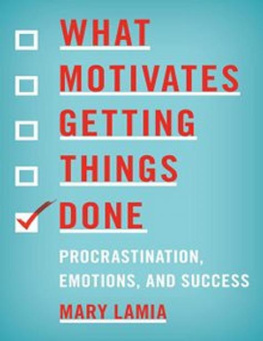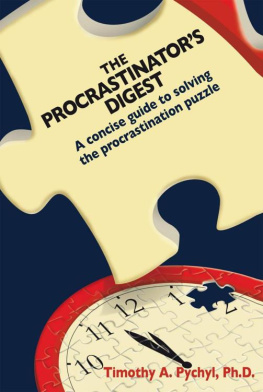What Motivates Getting Things Done
Procrastination, Emotions, and Success
Mary Lamia
ROWMAN & LITTLEFIELD
Lanham Boulder New York London
Published by Rowman & Littlefield
A wholly owned subsidiary of The Rowman & Littlefield Publishing Group, Inc.
4501 Forbes Boulevard, Suite 200, Lanham, Maryland 20706
www.rowman.com
Unit A, Whitacre Mews, 26-34 Stannary Street, London SE11 4AB
Copyright 2017 by Rowman & Littlefield
All rights reserved. No part of this book may be reproduced in any form or by any electronic or mechanical means, including information storage and retrieval systems, without written permission from the publisher, except by a reviewer who may quote passages in a review.
British Library Cataloguing in Publication Information Available
Library of Congress Cataloging-in-Publication Data Is Available
ISBN 978-1-4422-0381-5 (cloth: alk. paper)
ISBN 978-1-4422-0382-2 (electronic)
 TM The paper used in this publication meets the minimum requirements of American National Standard for Information Sciences Permanence of Paper for Printed Library Materials, ANSI/NISO Z39.48-1992.
TM The paper used in this publication meets the minimum requirements of American National Standard for Information Sciences Permanence of Paper for Printed Library Materials, ANSI/NISO Z39.48-1992.
Printed in the United States of America
Acknowledgments
Wisdom, information, and advice were offered by colleagues, friends, and family members throughout versions of the manuscript for this book. Much appreciation goes to Marilyn Krieger; Scott Hughes; William McCown; Gary David; Deborah Malmud; Linda McCarter; Jeanne Bergin; and Ann, Julian, David, and Frederick Parris. Jason Strauss and his assistants at the Wright Institute library helped with difficult-to-find resources for this book, and I am grateful for their time and efforts. Special appreciation goes to Suzanne Staszak-Silva for her confidence in my work.
I am truly indebted to numerous people who informed my understanding of what motivates them to get things done either ahead of schedule or at the deadline. Since stigma often accompanies procrastination, I hold in high regard all of the deadline-driven procrastinators who felt safe enough to be interviewed or to complete questionnaires that helped me understand what motivates their style of task completion. Not everyone who informed this work was successful at getting things done. Thus, I also want to express my admiration and hope for those who let me into their emotional lives in ways that provided insight as to why some people fail and, instead, attribute it to procrastinating.
Introduction
What motivates successful people to get things done? Maybe you assume their motivation is fueled by imagining a future reward for their efforts, including the joyful feeling of pride. However, a marvel of evolution is that humans are not solely motivated by positive emotions. They are also motivated, and even driven to achieve, by negative emotionsa primary, powerful, and often misunderstood source of motivation. How does that work?
Essentially, people are motivated to do something based on their desire to turn on positive emotions or to turn off negative emotions. Its just a fundamental principle about how we function emotionally. Labeling emotions as positive or negative has little to do with their value but instead involves how they motivate us through the ways they make us feel. Negative emotions, such as distress, fear, anger, disgust, and shame, motivate us to do something to avoid experiencing them, or they urge us to behave in ways that will relieve their effects. There is no doubt that negative emotions, along with positive ones, significantly influence our lives by silently directing the decisions we make and motivating us to get things done. Moreover, how we learn from dealing with core emotions, to a great extent, makes us who we become.
High achievers are motivated by their emotions to put effort into their work and never miss a deadline, although some may complete a task minutes before the cutoff point. In fact, while many successful people cant resist the urge to do things right away, countless others put things off until a deadline beckons them. The different timing of procrastinators and nonprocrastinators to complete tasks has to do with when their emotions are activated and what activates them. Through exploring the emotional lives of people who are successful in their endeavorsboth deadline-driven procrastinators and task-driven nonprocrastinators alikethis book explains how the human motivational system works, why people respond to it differently, and how to use it to your advantage. In these pages you will discover the impact of your emotional life on your style of doing, along with your way of being in the world. Youll understand why you should fear failure, the many ways in which anxiety is your friend, and how negative emotions can drive the pursuit of excellence.
Numerous studies have investigated procrastination behavior, often seeking to find some underlying pathology or undesirable characteristic that leads people to delay.
I could not write a book about the motivation to get things done without recognizing my readers will differ in what motivates their interest. Surely, some sections or chapters will captivate your interest more than others. The emotion of interest is one of the helpful innate tools that we have at our disposal to motivate task completion, yet our experiences lead us to differ in terms of what activates it. Therefore, I have written the book so that, if you prefer, you can skip around to sections that greater engage your attention or skip over sections that do not interest you. In some of the chapters I am prominently wearing my professorial hat, in others I use my voice as a clinician, and on occasion I am simply being human. In any case, I hope to resonate with you emotionally. Some people are excited by theory or details, whereas others are not. Given those differences, you will find endnotes for most of the chapters that include research and speculations for readers who are inclined to seek further information.
The first chapter provides an overview of what is covered in the book, including an evident example of a deadline-driven procrastinator, a task-driven nonprocrastinator, and a couple in the midst of attempting to navigate their divergent styles of getting things done. Chapter 2 describes some of the unique characteristics of deadline-driven procrastinators and task-driven nonprocrastinators. Some of the characteristics of procrastinators and nonprocrastinators are contrary to commonsense expectations! You may find yourself solidly identifying with the behavioral descriptions of a particular style. However, if you determine you do not have a dominant task-completion style, much like being ambidextrous, you may want to consider the elements of each style that may work best for you. Chapter 3 was written with the goal in mind of conveying what emotions are and how they operate. Learning just a little about the underpinnings of motivation can help you make use of the system that guides you.
If you are interested in understanding why you become anxious around tasks to complete, youll learn in Chapter 4 why anxiety can be a great friendperhaps even a personal coachwhen it comes to getting things done. If you are aware of fearing failure when something must get done, that information will be found in Chapter 5. There, you will discover why you should fear failure, more specifically, how shame anxiety can be highly motivating. However, if you are most interested in what drives people to achieve and why successful people tend to be perfectionists, then you will be drawn to Chapter 6, where you will discover what motivates the pursuit of excellence.









 TM The paper used in this publication meets the minimum requirements of American National Standard for Information Sciences Permanence of Paper for Printed Library Materials, ANSI/NISO Z39.48-1992.
TM The paper used in this publication meets the minimum requirements of American National Standard for Information Sciences Permanence of Paper for Printed Library Materials, ANSI/NISO Z39.48-1992.